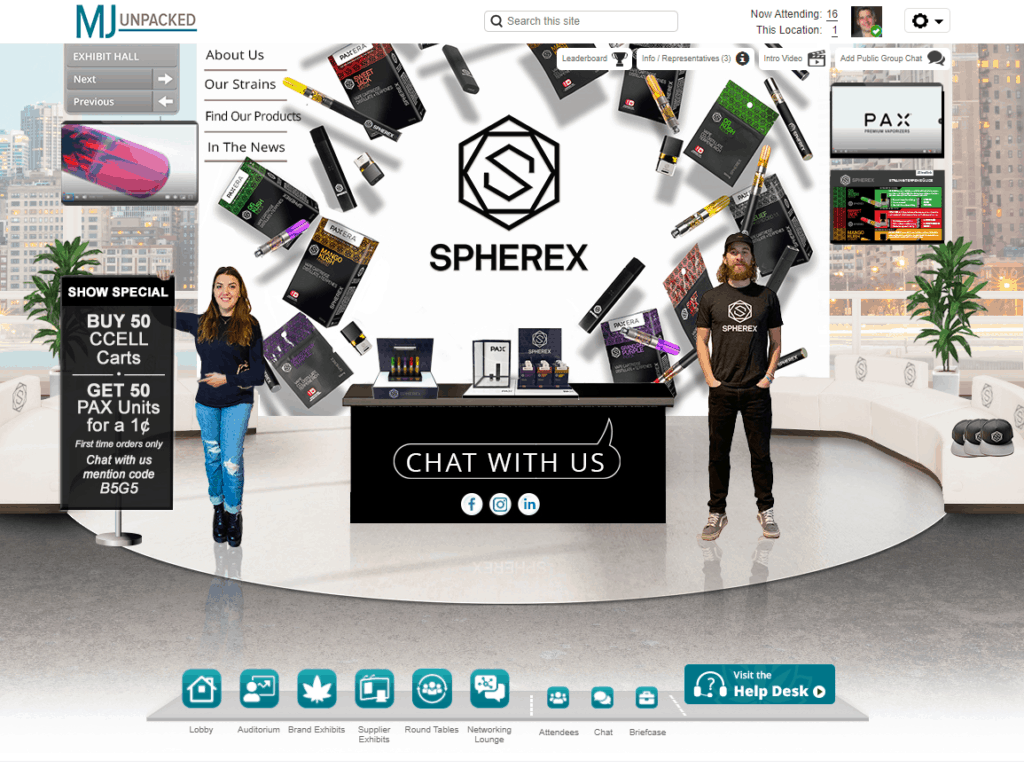Despite the pandemic raging around the world, effective vaccines seem to be a light at the end of the tunnel. Spoiler alert: live events are coming back! The question has never been if–it has always been when and how. But the “when” may be further away than you’d like to think. Read on for how to make the most of our current virtual reality and what to expect from the return of live events.
If anyone had told me what 2020 was going to be like, I might have reconsidered launching our events company in late 2019. But I’m glad we went ahead. The timing actually could have been much worse.
We were fortunate because we didn’t have to walk back a planned live event, find a way to replace 90%+ of our revenues, or reschedule the event only to eventually cancel. Instead we were able to pioneer the first virtual trade show for the cannabis industry, MJ Unpacked Colorado, followed by two shows for Californian and Midwestern markets. This experience has given us tremendous insight into audience behavior and attendee engagement.

If there’s one thing we’ve learned, it’s that people need events. And that we all want to get back to being together face to face. It is simply in our DNA.
Good News – Bad News
Since the pandemic hit, we’ve been forced to turn our focus into our homes, our minds, and our well-being, and perhaps this has instigated a collective awareness of the restorative and healing powers of cannabis. Whatever the case, the cannabis industry is crushing it in 2020.
Not so with the events industry. I’ve had countless conversations with trade show executives, senior hotel and convention center management, and travel industry professionals. The general consensus is that we won’t see the return of live events until late Q2 or early Q3 2021…at best.
We will not see the return of live events until late Q2 or early Q3 2021.
This is not just unfortunate for the event producers, but for our industry as a whole. Trade shows are the economic engines of industry where new products, technologies, and companies are launched, where professional networks are expanded, and where professional development occurs.
In the meantime, we’ll be stuck in Dante’s Seventh circle of Zoom meetings. But hell isn’t necessarily a bad place; it just requires the right perspective.
The rise of the machines
The limitations of virtual events have been evident since their inception.
I’ve launched trade shows and built communities for nearly 30 years. I was around when virtual events were introduced in the late 90s/early 00s. By the reaction in the industry, you’d have thought Reagan made a joke about nuking the Russians. Suddenly we trade show producers were imagining we’d be replaced by hollow digital versions of ourselves. That didn’t happen. Our innate need for social interaction and the frail ego’s desire to belong to a tribe (or business community) facilitated massive growth in the live trade show industry over the past 20 years.
But that came to a screeching halt this year, and we were forced back to the hollow digital versions of ourselves.
My friend Greg James at Marijuana Venture has been quick to point out that all virtual events are duds. I disagree with Greg. Not all virtual events are duds, but he’s right that there’s a sea of redundancy, poor execution, and over promotion–that also existed in the live event space pre-Covid.
For example, a recent virtual event promoted itself as “the most anticipated virtual event of the year” with over 5,000+ attendees. When I logged in, there were never more than 150 people in the event. When contemplating the possible origin of these exaggerated claims, it’s helpful to understand that most of us who produce and promote events believe we are part of an illegitimate bloodline of P.T. Barnum.
Before we dig in to how to avoid over selling and thus make the most of our new virtual reality, let’s define the three main types of virtual events we’re seeing in the cannabis industry.
The broadcast webinar model
Webinars have been with us for a while and are often part of an individual company’s content marketing strategy. They are usually free to attend with the primary goal of lead gen for the producer. They typically don’t allow for interaction between the attendees and usually have very high attrition.
The matchmaking model
Sometimes called the ECRM model for the company who pioneered the technology, these events can facilitate direct sales but are limited in the number of virtual meetings, the ability of the organizer to get legitimate buyers to engage, and the buyers’ willingness to take on new products.
The virtual trade show experience
Here the core aspects of a live event – exhibit halls, conference sessions, and networking – are brought to life via a virtual event environment. Virtual trade shows are becoming the most popular option and, when done properly, can be efficient networking opportunities that provide incredibly detailed lead gen data. This is the model we used for our first three MJ Unpacked events.

What we’ve learned
Speaking from experience, virtual events are hard. Much harder than producing a live event. In all the models, we are competing for attention span. And when you no longer have a captive audience and your delegates are sitting at home with a thousand distractions, it’s difficult to win that battle.
Virtual events are eerily unnatural. They lack the vibrancy, excitement, and adrenaline rush of being at the live event. The crux of virtual event success is being able to break through the fourth wall, a metaphorical divide between cast and audience, so the attendees feel like they are in the moment. Live. At the event.
Things to remember when considering a virtual event
First, virtual events are not buying events. While the digital experience has virtual booths, attendees want to browse but not engage in a direct sales conversation. Especially in our industry, people want to build a relationship and trust before entering into a transaction. It’s crucial to understand the buying process and how a virtual event can seed but not consummate transactions.

Second, content is king. This is the same at live events. Content is a powerful magnet for attendance, as it delivers the opportunity for professional development. This requires hearing from thought leaders and actual operators. In this context, it’s important to bring fresh ideas to the stage, not the circuit speakers who have a canned speech we’ve heard before.

On the topic of content, I have seen far too many virtual events that allow top advertisers to covertly sell from stage. Or, more overtly, some offer up their stage as part of a sponsorship package. Be wary of these events–they have a short lifespan. Trade shows are media and there needs to be a clear separation of church and state.
Third, on-demand is not in demand. Many events are promoting that they’re available for months following the event. But once the live event is over, no one is showing up at the party.
Last, networking is the foundational benefit from attending a show. How many people are attending is less important than who is attending. Most virtual events offer the opportunity to directly interact during the live event through chat or video. The value of this interaction is a function of the quality of the audience.
The reality is that for the immediate future we are forced to live out our lives as digital selves, like a bad Second Life nightmare. But do not despair! As the great grandson, twice removed, from the illegitimate child of P.T. Barnum’s cousin, I am excited for this brave new world.
What to expect from the return of in-person events
Traversing back to when and how live events will return, the “when” will remain a moving target until we have a clear path to disseminating a vaccine to the populous. The “how” is a predictable path based on history. To model the expected return to live events, we can use what we learned from the SARS virus, the H1N1 pandemic, and the financial collapse of 2008.
88% of attendees want to return to live events, but 65% required some level of risk mitigation.
There will be a new normal.
Risk mitigation will be the priority. Per a recent study by GES, 88% of attendees want to return to live events, but 65% required some level of risk mitigation. Being able to provide a safe environment beyond masks and hand sanitizer will be a requirement for any event to proceed as we recover from this pandemic. Fortunately, there are some brilliant minds solving this problem as a function of the economic value of the trade show, hospitality, hotel and travel industry.
Large events will recover slowest. Due to the increased risk of exposure, people will avoid large pan-industry events and instead opt for events with smaller audiences that are more relevant to their business objectives. Very simply: quality over quantity.
There will be a thinning of the herd. The running joke in the cannabis industry is that you could attend an event every week. Unfortunately, many existing event producers who received deposits for events in 2020 are burning cash during the pandemic. When we return to live events, they may not have the means to deliver the product that exhibitors have paid for.
Exhibitors and sponsors will demand better terms. Too many organizers unilaterally held deposits for a product they technically did not deliver. Following this egregious usurpation of capital from our industry, exhibitors will demand more favorable cancellation clauses in their exhibit contract. Gone (for now) are the days of paying in full 6 to 12 months out from an event.
This will require a shared responsibility for the event success between the producer and exhibitors which requires greater transparency from the event producer. This means honest communication on the number of expected attendees, any current risks facing the show, HIPPA-compliant reporting of any positive cases and confirmation that they have been isolated from the event population.
Attendees will be fewer and sign up later. Companies will limit their liability and send only one or two executives to an event. The normal flighting of attendee registration is 40% sign up 2-3 months out deadline, 40% sign up before one week out deadline, and 20% sign up on site. That’s going to change. As the pandemic, or future pandemics, may be with us for a while, it’s a conservative financial strategy to hold off on confirming until you know the event will take place. It’s plausible that as many as 70% of the attendees will not commit to the event until they arrive onsite.
How we do this matters
Trade markets date back to the dawn of civilization. After years of churning through cannabis event after cannabis event, we are all yearning to just be able to go back to the worst event we attended to relive the experience and excitement. But how we return truly puts people’s lives in the balance.
The bottom line is that none of us, both the producers and the consumers of events, have ever experienced “this.” A complete shutdown of the economy and a great pause of society. It is important for us to feel the weight and gravity of this change.
As I mentioned at the onset, there has been extraordinarily positive news about potential vaccines, but these will take many months, or even a year, to deploy. And that process will require mindfulness, purpose, and precaution.
Event producers will need to prioritize public safety. Period. They will need to demonstratively show their support and service to our industry through their actions. And then we can get back to the trade shows and conferences that drive innovation, thought-leadership, and commerce. Channeling my inner-P.T. Barnum, “the noblest art is that of making others happy.”
We are looking forward to bringing the joy and happiness of events back to our community and industry. In Q1 of 2021, we will be offering a unique digital event experience that will not just break through the 4th wall, but be entirely focused on audience participation. And we are actively building our new live event model and securing for the safe return to in person events.






1 thought on “The future of cannabis events”
Pingback: News Roll Up: MORE Act Set for Historic House Vote | Cannabis News & Culture: Heady Vermont